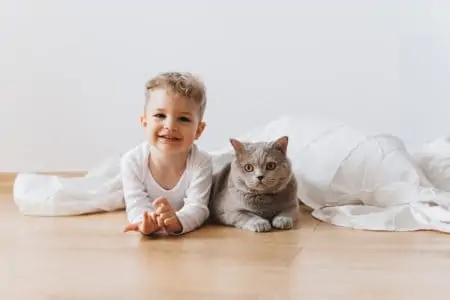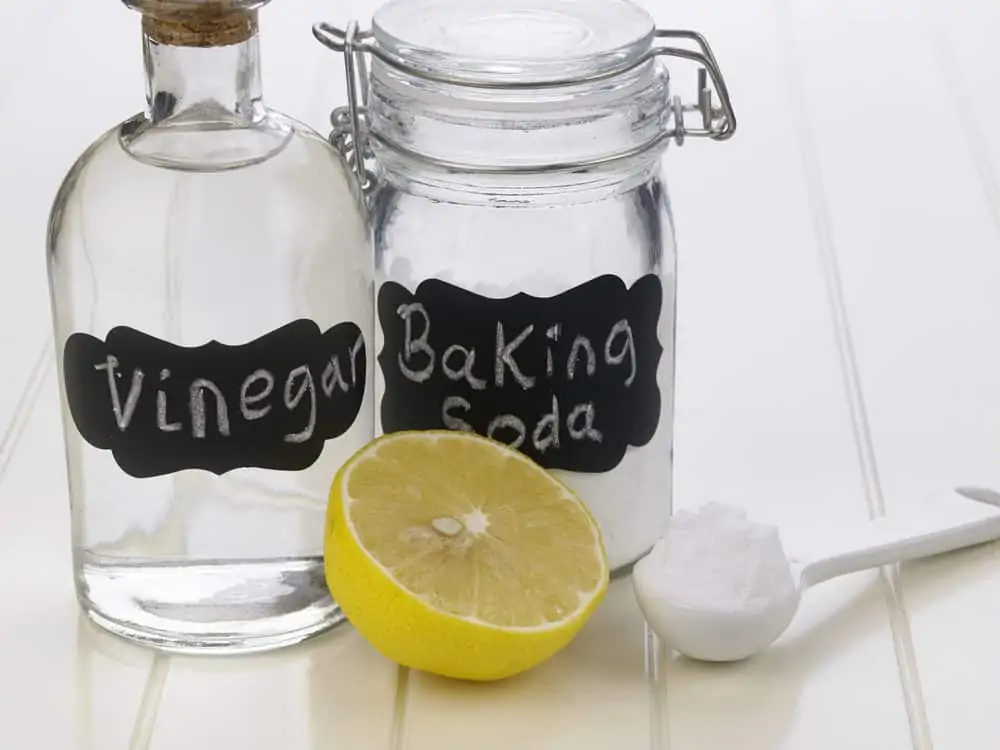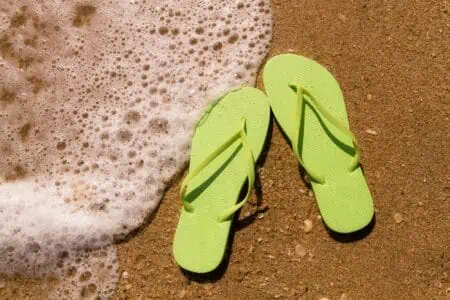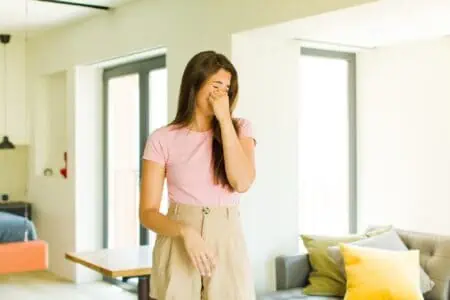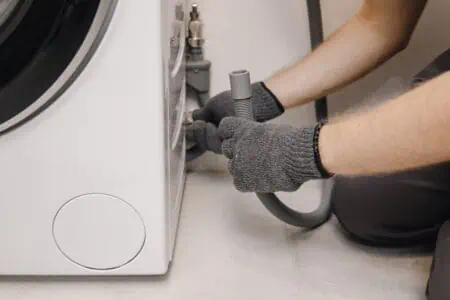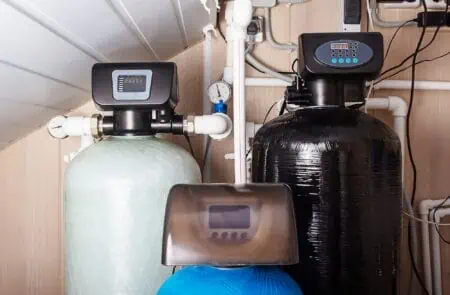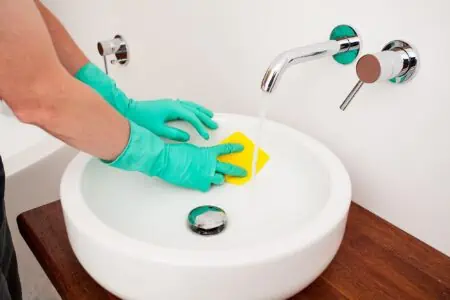Potty training a pet is one of the longest and hardest aspects of inviting a furry friend into your home. If your pet is having accidents on your hardwood floors, this can lead to an inconvenient mess. But that’s not all — it can also cause long-term damage and odor problems.
But with the right methods and products, you can tackle the issue. We’ll show you how to get rid of pet odor on hardwood floors. Next time guests come round to your house, they won’t know that your little friend had an accident earlier in the week!
Key Takeaways
- Pet urine can cause permanent damage and odor in hardwood floors, so tackle accidents immediately.
- A homemade solution of distilled white vinegar, baking soda, and dish soap can help remove odors and stains.
- For sealed hardwood floors, using a pet odor remover product specifically designed for hardwood is recommended.
- Prevent damage by properly sealing floors, using puppy pads during training, and establishing a consistent toilet routine for your pet.
Can Dog Urine Ruin a Hardwood Floor?
Yes, pet urine can cause permanent damage. Dog urine can penetrate the wood and go beneath the flooring, which leads to both discoloration and a permanent stench. Sometimes the only way to get rid of the smell is to replace the flooring.
You may not even notice the permanent damage until a hot summer’s day highlights the bad stench. So we can try our best to get rid of pet odor in hardwood floors, but be aware that it might come back to haunt you in a couple of months.
Cleaning Sealed vs Unsealed Hardwood Floors
Whether you have sealed or unsealed hardwood floors, pet urine can still make its way through and leave a permanent stench. A good polyurethane seal on your floors is the best you can do against pet damage, but it won’t fully protect the wood.
If you’re curious how well your floors are sealed, drop a little water onto the floor in an inconspicuous spot and wait a couple of hours. If it’s still standing there, then your floors have great protection.
You should reseal your floors every so often anyway, especially after installation which can open up the seams again.
As for unsealed hardwood floors, it’s going to be much easier for the pet urine to permeate the wood and cause long-term damage. If you don’t tackle this right away, you may never get the floors clean or odor-free. Even if you do deal with it immediately, it can still cause damage.
If you have engineered hardwood, you still need to be careful. Since it’s still made of wood, it can hold moisture. While it’s less likely to lead to permanent damage, you should still follow these steps where possible to avoid long-term damage.
How to Get Rid of Pet Odor in Hardwood Floors
Let’s get into the best methods for getting rid of pet odor in your hardwood floors.
Hardwood floors are an expensive luxury, so it’s important to keep them in mint condition. In fact, if you’re planning on doing up your home, and installing hardwood floors, we seriously recommend waiting until your pet is fully house trained.
Pro Tip
Baking Soda
Here at Oh So Spotless, we love a baking soda hack! This one is great for dealing with pet urine messes.
- Soak up as much of the urine as possible with paper towels.
- Rinse the area with a damp cloth.
- Dry with a towel.
- Sprinkle baking soda generously over the spot where your pet peed.
- Let the baking soda sit there for at least eight hours. The baking soda will absorb moisture and kill odors.
- Vacuum it up carefully.
- Disinfect the floors with a hardwood-safe product.
Make sure to wash the towel at a high temperature and put it in the tumble dryer to kill germs from the urine.
Pet Odor Remover Product
This method is best for sealed hardwood floors. We have two big bottles of pet odor remover liquid in our cupboard. It’s important to buy this before you even bring your puppy home — you’ll need it. We promise!
Just make sure the product you choose is safe on hardwood floors.
- Soak up excess pee with paper towels.
- Rinse the area with a damp cloth or sponge.
- Dry thoroughly with a towel.
- Spray the odor-removing product to the affected area.
- Leave it for the recommended amount of time as stated on the packaging.
- Wipe the area with a clean damp cloth or sponge.
- Rinse the area with fresh water.
- Thoroughly dry the area with a clean towel.
Again, make sure to clean the cleaning tools you used — sponges, cloths, towels — in a hot wash to kill germs.
Sand the Floors
If your floors are unfinished or finished poorly, you may need to sand them back to get rid of the pet odor smell once and for all.
For solid hardwood floors, you can use a disc sander and a drum sander. If you have engineered wood floors, you can use a disc sander. However, make sure to do light sanding as the top layer of wood is too thin for deep sanding.
Before you start, make sure your pets aren’t nearby. It’s dangerous for them, but it’s also going to be really bad if they pee on the floors before you’ve resealed them after sanding.
- Determine whether you need to do deep or light sanding. Use a vibrating floor sander or floor disk sander for light sanding. Use a drum sander for deeper sanding. You may need an edge sander for baseboards and trim. You can buy your own or rent any of these.
- Tape up plastic sheeting anywhere where dust might escape. This includes windows and doors.
- Prep for sanding by removing quarter-road and the baseboards. If the baseboards are painted, then leave them on and just sand as close as possible without damaging them.
- Sand the floors. When using a drum sander, be patient and never press down as this can damage the floors. Never leave a sander in place while running; always keep moving.
- After you’ve finished sanding, sweep the floors.
- Mop the floors twice, using a different mop head each time.
- Apply a floor finish.
Household Item Mix
Don’t have a pet odor remover product, and don’t need to sand back your floors? This is a good method for removing old pet stains and smells from all kinds of wood floors.
- Mix together ⅓ cup of distilled white vinegar, ¼ cup of baking soda, and a drop of dish soap in a cup.
- Put it into a spray bottle and saturate the affected area.
- Let it sit for 15 minutes.
- Wipe it up with a clean cloth.
- Sprinkle baking soda over the area and leave it overnight.
- Vacuum in the morning.
- Repeat if the odor is still there.
Top Tip
Will Hydrogen Peroxide Damage Hardwood Floors?
No — hydrogen peroxide is safe on hardwood floors. It’s more for stains than odors, which is why we haven’t suggested it. Still, if you have gotten rid of the odor but still have a stain, this is a good thing to try.
- Pour 3 percent hydrogen peroxide into a spray bottle and apply it to the stain.
- Let it sit for a few minutes before wiping with a microfiber cloth.
- You’ll need to use some elbow grease for stubborn stains.
- Rinse the area.
- Dry thoroughly.
Test in an inconspicuous spot first to be sure the hydrogen peroxide won’t discolor your floors.
How Can I Protect My Hardwood Floors from Dog Urine?
Prevention is easier than fixing the problem. So if you’re wondering how to protect your lovely hardwood floors, here are our top tips:
- Firstly, don’t let your pets near your hardwood floors while they’re still being housetrained. This sounds mean, but pets need to earn access to the whole house. Our dog currently only has access to two rooms unsupervised, since she’s still being house-trained. If you have hardwood floors, keep that room a pet-free zone if possible.
- If it’s not possible to keep your pet away from your hardwood floors, lay down puppy pads while they’re still being house-trained.
- Seal the floors with a high-quality sealer that protects the floors against moisture damage. Make sure to reapply the sealant as often as the manufacturer suggests.
- Apply a penetrating oil. This is a more natural and strengthening option than certain sealers. It strengthens the fibers of the floors so they can handle pet urine better, making it easier to clean when it does happen.
- Overnight, put your pet in a crate so they can’t pee on the hardwood floors. Crates are not nasty — they’re actually really helpful for dogs. Our dogs have all loved their crates and sleep safely and soundly in them overnight.
FAQs
No More Pet Pee
With these tips, you can get rid of pet odor on hardwood floors. Our four awesome methods will help you tackle deep penetrating signs of odors, but we still recommend tackling the issue immediately.
The best tip is prevention. Make sure that your pet is supervised, has a toilet routine, and has access to puppy pads if they’re still peeing indoors. You could also try keeping them away from hardwood floors, or popping them in a crate when you’re asleep or out somewhere.
